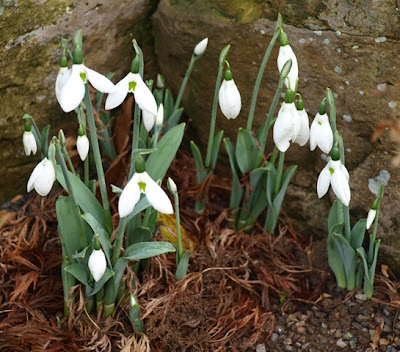Legalising the snowdrop trade in Georgia
ვაჭრობა თოვლი წვეთები საქართველოში. It's nearly Christmas, we had our first snow fall and the snow drops are out. On the down side, it's cold and snowdrops in Georgia are under pressure from over harvesting.
The cold is easy to deal with - more layers! And the shortest day of the year is six days away and then we are on our way towards that long summer twilight. At least that's the way I like to think about it.
As an aside, winter has been a revelation so far. I hadn't realised how beautiful Kew Gardens could look with the leaves blown off the deciduous trees, revealing stems of all colours and textures. In the weak winter sun it's like living in an etching. A stark beauty, but quite the antidote to the gaudy greens and showy blooms of spring and summer. By late February I'm sure I'll be willing back the flowers and leaves but for now I have my winter garden and frosty lawns to savour.
There are flowers of course. The snow drops are the most obvious but also Viburnum blooms - which should be called mini-snowballs - and some early daffodils.
Snow drops are the common name for species of Galanthus, a genus related to Amaryllis (Belladonna Lily) with about 20 species, most of them with white flowers.
The Common Snowdrop, common by name and common by nature in at least UK and Australia, is Galanthus nivalis, native to Europe across to Ukraine and Turkey. In Kew Gardens, the snowdrop in bloom now (and illustrated here and at the top) is the Giant Snowdrop Galanthus elwesii, from similar areas but starting further east.
The name refers to the tallness of the flowering stems not the flower size and I've seen it amusingly described as flowering in 'extremely early spring' - i.e. the start of winter - while the Common Snowdrop is described as flowering 'very early spring' - perhaps mid-winter. Some fuel for my seasonal musings...
Another popular snowdrop in UK gardens is Galanthus woronowii, native to Turkey, Russia and Georgia. Trade in all snowdrops (which I know sounds less exciting than cocaine or weapons) is controlled by CITES - the Convention on International Trade of Endangered Species - even though most are not actually endangered, yet. This picture of the species growing wild in Georgia is from Kew's head of Conventions and Policy, Noel McGough.

Following the break up of the USSR, Turkish traders headed into Georgia and snowdrops took their fancy. Snowdrops (in this case Galanthus woronowii) seemed to be common so they started to trade with contacts in the Netherlands, via Turkey. Georgians had other things on their minds at the time but eventually CITES asked the local authorities to review whether trade in snowdrops was sustainable.
Two years ago the Dutch government, Royal Botanic Gardens Kew, Microsoft Research and the government of Georgia surveyed wild and cultivated populations and decided that there was a potential harvest of 300 million bulbs. Based on this data, yearly harvest quotas and management regimes have been introduced and CITES has now agreed to Georgia continuing to export its snowdrop bulbs, under this new system.
Kew's relationship with Georgia continues, encouraging them to host a European Regional CITES Plants Committee meeting (picture below) to show off their approach to sustainable trading, and earlier this year brokering (as part of the Plants Committee) a successful meeting between Dutch bulb importers and Georgian traders.
Georgian snowdrops can now be traded legally and without leading to the extinction of the species in the wild. That's a good thing for us all.
In the meantime, here is my first snow in the UK, a dusting at Wakehurst Place and here along the M5...




Comments